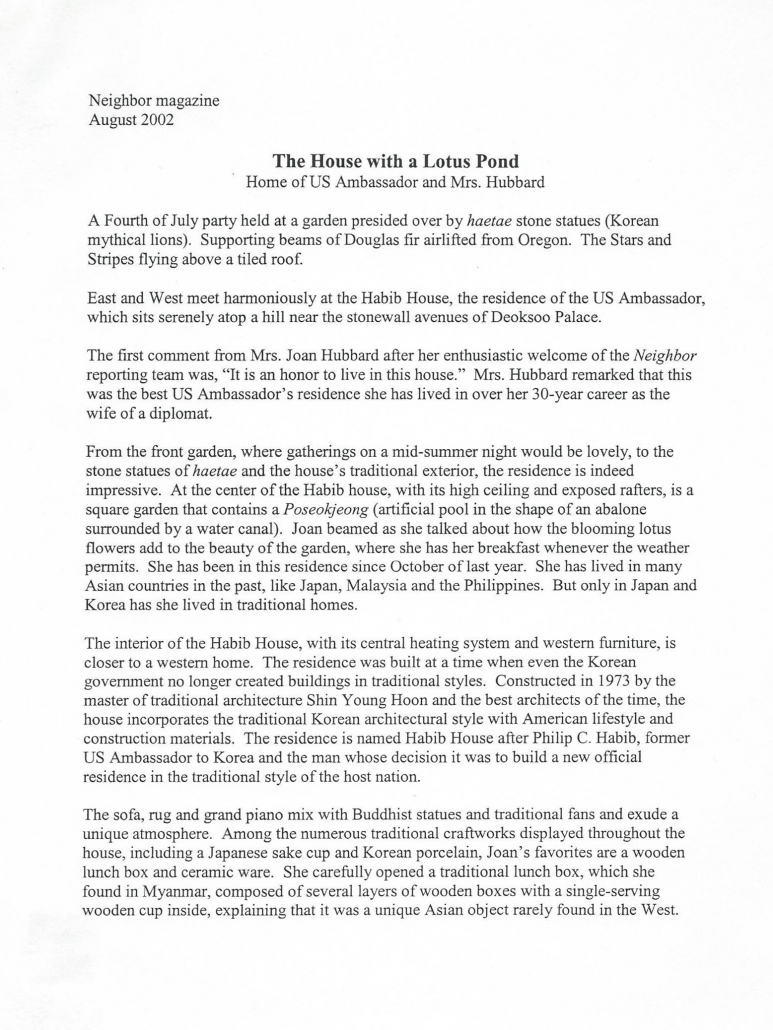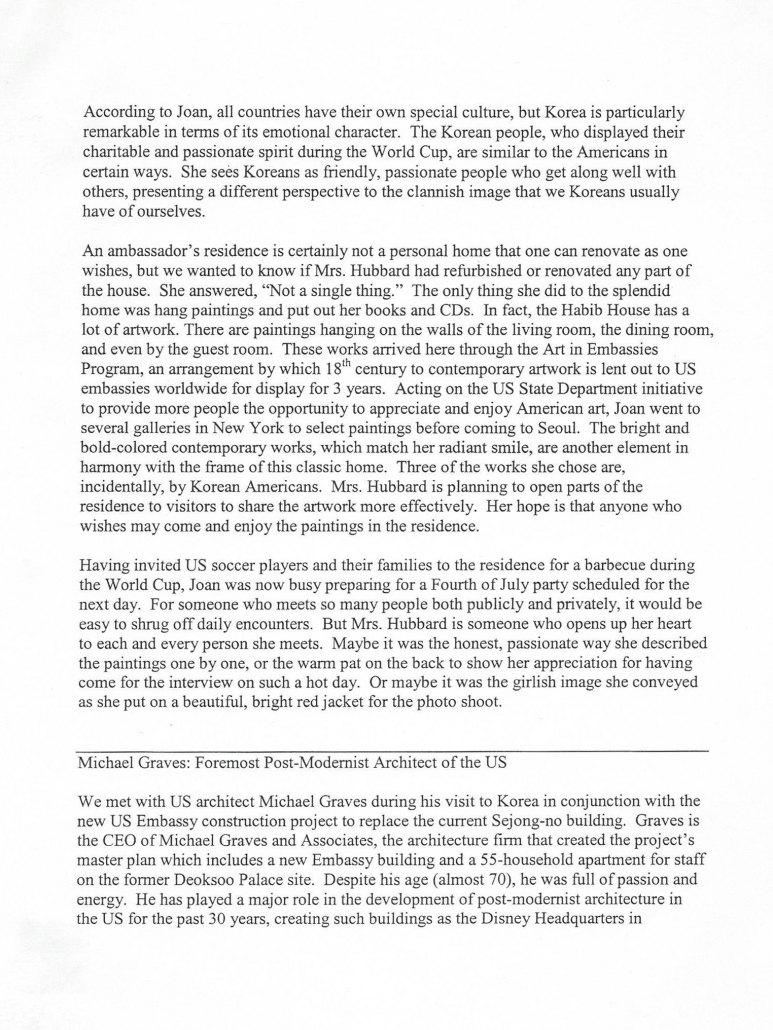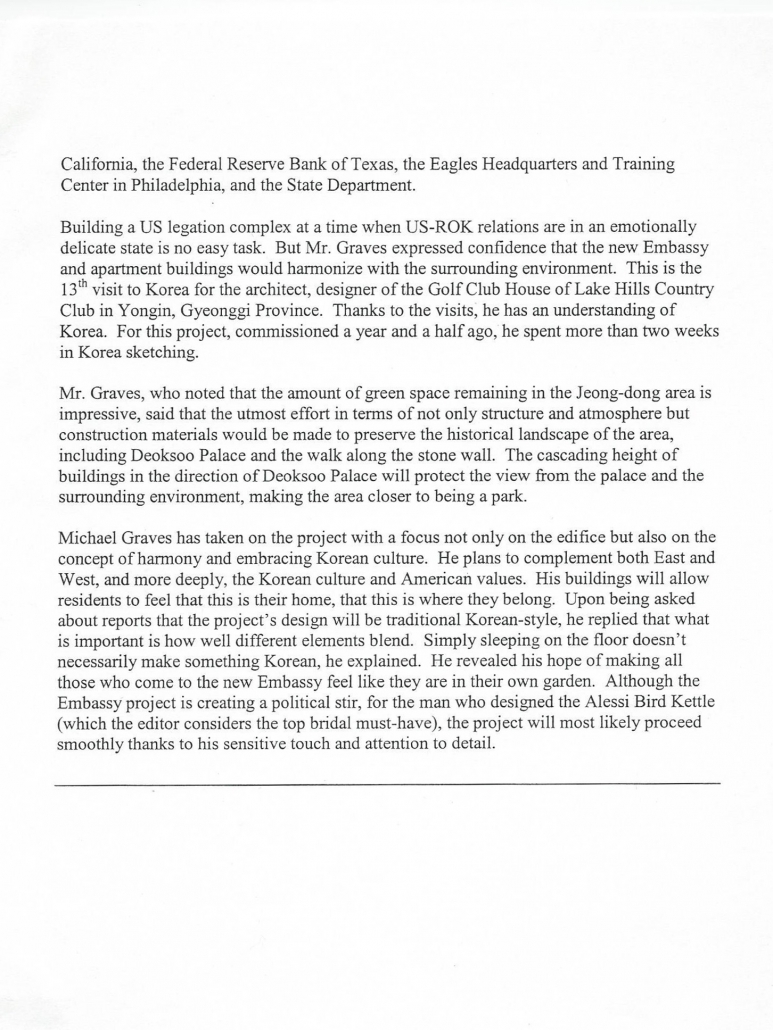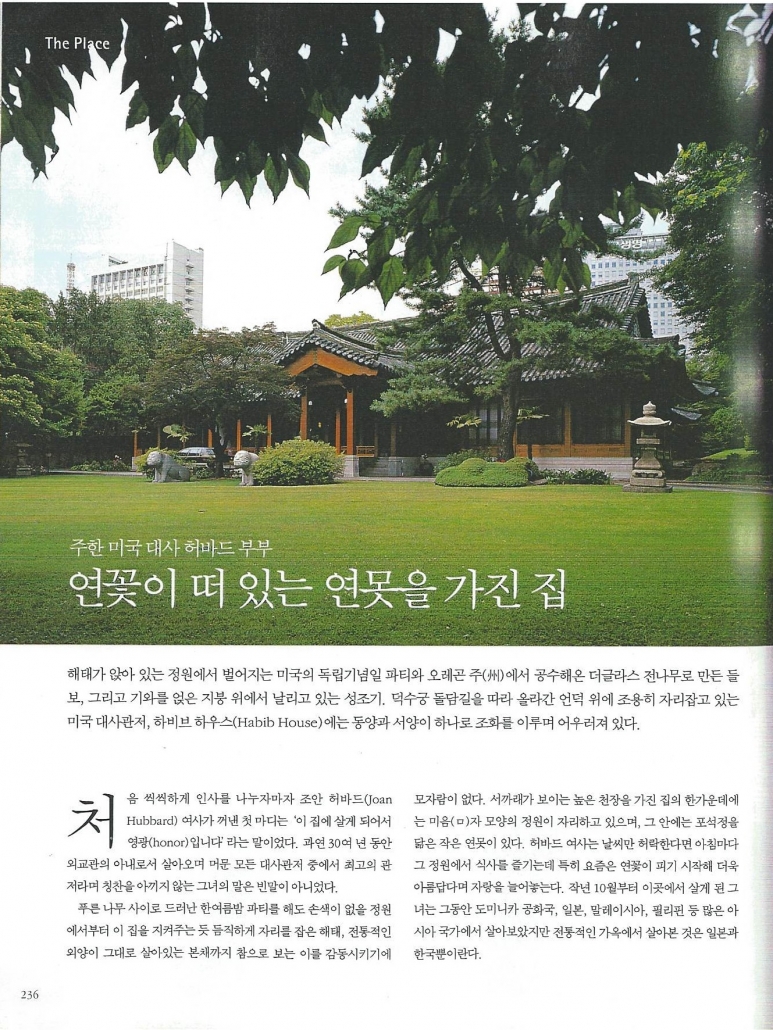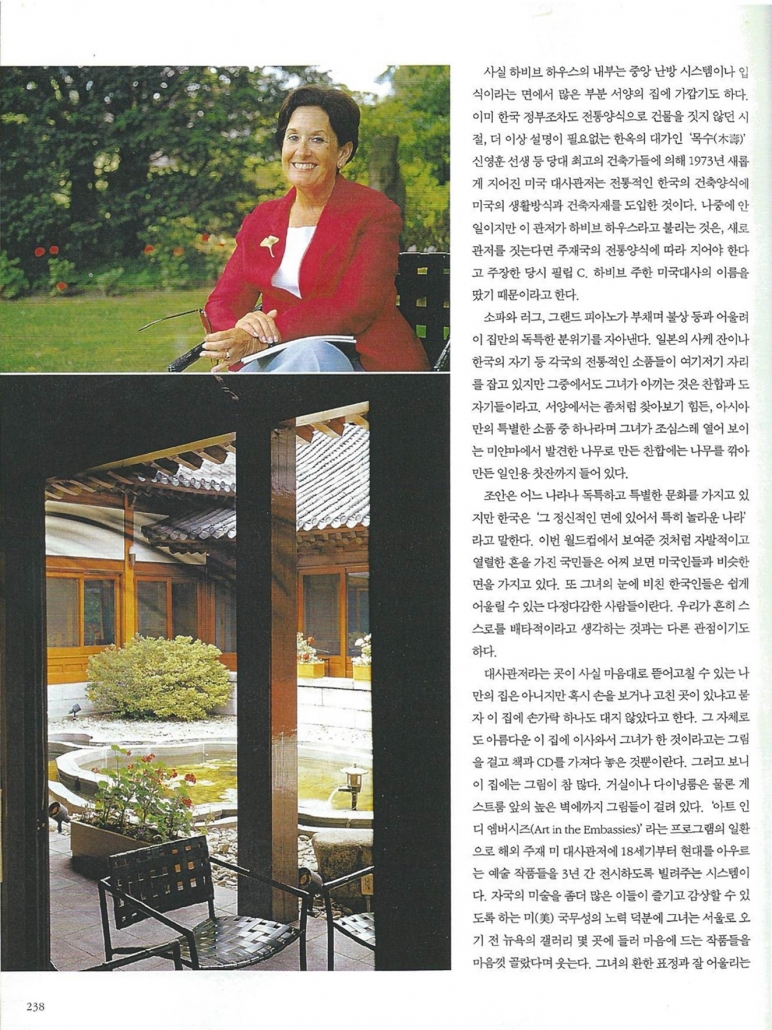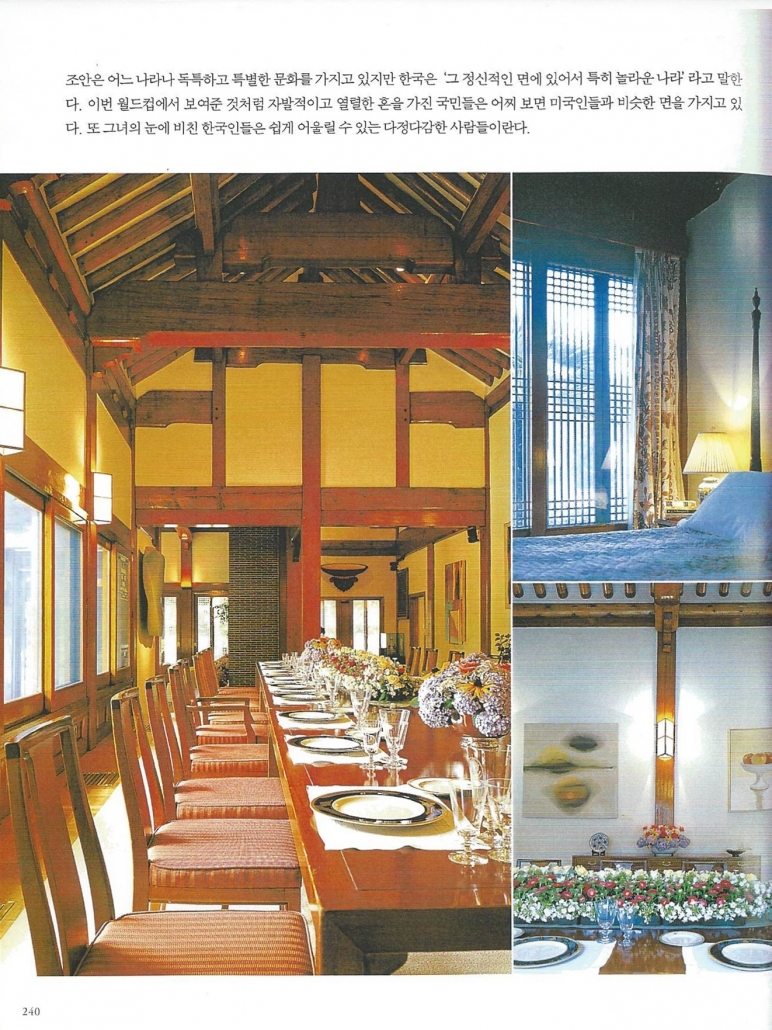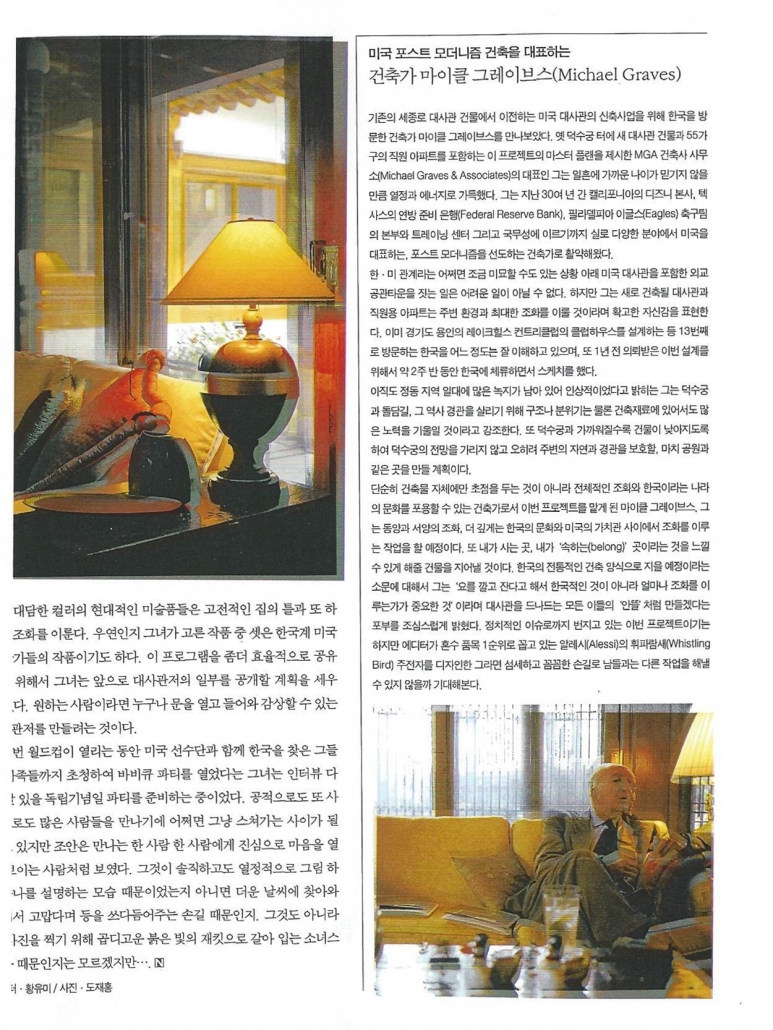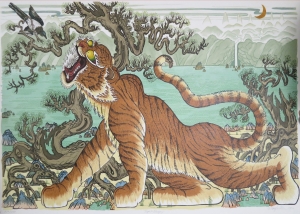The House With a Lotus Pond
Home of US Ambassador and Mrs. Hubbard
Neighbor Magazin, August, 2002
A Fourth of July party held at a garden presided over by haetae stone statues (Korean mythical lions). Supporting beams of Douglas fir airlifted from Oregon. The Stars and Stripes flying above a tiled roof.
East and West meet harmoniously at the Habib House, the residence of the US Ambassador, which sits serenely atop a hill near the stonewall avenues of Deoksoo Palace.
The first comment from Mrs. Joan Hubbard after her enthusiastic welcome of the Neighbor reporting team was, “It is an honor to live in this house.” Mrs. Hubbard remarked that this was the best US Ambassador’s residence she has lived in over her 30-year career as the wife of a diplomat.
From the front garden, where gatherings on a mid-summer night would be lovely, to the stone statues of haetae and the house’s traditional exterior, the residence is indeed impressive. At the center of the Habib house, with its high ceiling and exposed rafters, is a square garden that contains a Poseokjeong (artificial pool in the shape of an abalone surrounded by a water canal). Joan beamed as she talked about how the blooming lotus flowers add to the beauty of the garden, where she has her breakfast whenever the weather permits. She has been in this residence since October of last year. She has lived in many Asian countries in the past, like Japan, Malaysia and the Philippines. But only in Japan and Korea has she lived in traditional homes.
The interior of the Habib House, with its central heating system and western furniture, is closer to a western home. The residence was built at a time when even the Korean government no longer created buildings in traditional styles. Constructed in 1973 by the master of traditional architecture Shin Young Hoon and the best architects of the time, the house incorporates the traditional Korean architectural style with American lifestyle and construction materials. The residence is named Habib House after Philip C. Habib, former US Ambassador to Korea and the man whose decision it was to build a new official residence in the traditional style of the host nation.
The sofa, rug and grand piano mix with Buddhist statues and traditional fans and exude a unique atmosphere. Among the numerous traditional craftworks displayed throughout the house, including a Japanese sake cup and Korean porcelain, Joan’s favorites are a wooden lunch box and ceramic ware. She carefully opened a traditional lunch box, which she found in Myanmar, composed of several layers of wooden boxes with a single-serving wooden cup inside, explaining that it was a unique Asian object rarely found in the West.
According to Joan, all countries have their own special culture, but Korea is particularly remarkable in terms of its emotional character. The Korean people, who displayed their charitable and passionate spirit during the World Cup, are similar to the Americans in certain ways. She sees Koreans as friendly, passionate people who get along well with others, presenting a different perspective to the clannish image that we Koreans usually have of ourselves.
An ambassador’s residence is certainly not a personal home that one can renovate as one wishes, but we wanted to know if Mrs. Hubbard had refurbished or renovated any part of the house. She answered, “Not a single thing.” The only thing she did to the splendid home was hang paintings and put out her books and CDs. In fact, the Habib House has a lot of artwork. There are paintings hanging on the walls of the living room, the dining room, and even by the guest room. These works arrived here through the Art in Embassies Program, an arrangement by which 18″ century to contemporary artwork is lent out to US embassies worldwide for display for 3 years. Acting on the US State Department initiative to provide more people the opportunity to appreciate and enjoy American art, Joan went to several galleries in New York to select paintings before coming to Seoul. The bright and bold-colored contemporary works, which match her radiant smile, are another element in harmony with the frame of this classic home. Three of the works she chose are, incidentally, by Korean Americans. Mrs. Hubbard is planning to open parts of the residence to visitors to share the artwork more effectively. Her hope is that anyone who wishes may come and enjoy the paintings in the residence.
Having invited US soccer players and their families to the residence for a barbecue during the World Cup, Joan was now busy preparing for a Fourth of July party scheduled for the next day. For someone who meets so many people both publicly and privately, it would be easy to shrug off daily encounters. But Mrs. Hubbard is someone who opens up her heart to each and every person she meets. Maybe it was the honest, passionate way she described the paintings one by one, or the warm pat on the back to show her appreciation for having come for the interview on such a hot day. Or maybe it was the girlish image she conveyed as she put on a beautiful, bright red jacket for the photo shoot.
Michael Graves: Foremost Post-Modernist Architect of the US
We met with US architect Michael Graves during his visit to Korea in conjunction with the new US Embassy construction project to replace the current Sejong-no building. Graves is the CEO of Michael Graves and Associates, the architecture firm that created the project’s master plan which includes a new Embassy building and a 55-household apartment for staff on the former Deoksoo Palace site. Despite his age (almost 70), he was full of passion and energy. He has played a major role in the development of post-modernist architecture in the US for the past 30 years, creating such buildings as the Disney Headquarters in
California, the Federal Reserve Bank of Texas, the Eagles Headquarters and Training Center in Philadelphia, and the State Department.
Building a US legation complex at a time when US-ROK relations are in an emotionally delicate state is no easy task. But Mr. Graves expressed confidence that the new Embassy and apartment buildings would harmonize with the surrounding environment. This is the 13th visit to Korea for the architect, designer of the Golf Club House of Lake Hills Country Club in Yongin, Gyeonggi Province. Thanks to the visits, he has an understanding of Korea. For this project, commissioned a year and a half ago, he spent more than two weeks in Korea sketching.
Mr. Graves, who noted that the amount of green space remaining in the Jeong-dong area is impressive, said that the utmost effort in terms of not only structure and atmosphere but construction materials would be made to preserve the historical landscape of the area, including Deoksoo Palace and the walk along the stone wall. The cascading height of buildings in the direction of Deoksoo Palace will protect the view from the palace and the surrounding environment, making the area closer to being a park.
Michael Graves has taken on the project with a focus not only on the edifice but also on the concept of harmony and embracing Korean culture. He plans to complement both East and West, and more deeply, the Korean culture and American values. His buildings will allow residents to feel that this is their home, that this is where they belong. Upon being asked about reports that the project’s design will be traditional Korean-style, he replied that what is important is how well different elements blend. Simply sleeping on the floor doesn’t necessarily make something Korean, he explained. He revealed his hope of making all those who come to the new Embassy feel like they are in their own garden. Although the Embassy project is creating a political stir, for the man who designed the Alessi Bird Kettle (which the editor considers the top bridal must-have), the project will most likely proceed smoothly thanks to his sensitive touch and attention to detail.

